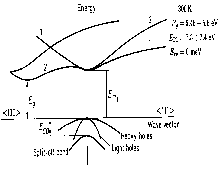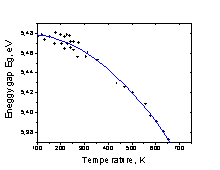NSM Archive - Diamond (C) - Band structure and carrier concentration

Band structure and carrier concentration
Basic ParametersTemperature Dependences
Effective Masses and Density of States
Donors and Acceptors
Basic Parameters
| Energy gap | 5.46-5.6 eV |
| Energy separation (EΓ1) | 7.3-7.4 eV |
| Energy of spin-orbital splitting Es0 | 0.006 eV |
| Intrinsic carrier concentration | ~10-27 cm-3 |
| Intrinsic resistivity | ≥1042Ω·cm |
| Resistivity of diamonds types I and IIa (usually) | ~1016Ω·cm |
| Resistivity of diamonds type IIb | ~1-103Ω·cm |
| Effective conduction band density of states | ~1020 cm-3 |
| Effective valence band density of states | ~1019 cm-3 |
 |
Band structure and carrier concentration of Diamond. 300 K
|
Temperature Dependences
 |
Temperature dependence of the energy gap (Clark et al., 1964) |
dEg/dT=-(5.4±0.5)·10-5 eV K-1 (Vavilov and Konorova [1976]).
dEΓ1/dT=-6·10-4 eV K-1 (Clark et al. [1964]).
Effective Masses and Density of States
Electrons
The surfaces of equal energy are ellipsoids.
ml=1.4mo
mt=0.36mo
Effective mass of density of states in one valley of conduction band
mc=(ml·mt2)1/3=0.57mo
There are 6 equivalent valleys in the "Si-like" conduction band of diamond.
Effective mass of density of states for all valleys of conduction band mcd≈
1.9mo
Effective mass of conductivity mcc=3(1/ml+ 2/mt)-1=0.48mo
Holes
Cyclotron resonance measurement date (Rauch [1962]):
| heavy | mh= 2.12mo |
| light | mlp= 0.7mo |
| split-off band | mso=1.06mo |
Effective mass of density of states mν=0.8mo
There is a considerable uncertainty regarding the density of states effective mass. There is a considerable uncertainty regarding the density of states effective mass. The values as low as mν=0.16mo (Kemmey and Wederpohl [1965]) and as high as mν=1.1mo (Dean [1965]) have been reported. For estimations, one can use the value of mν=0.8mowhich is close to mν=0.75mo (Collins and Williams [1971]) and mν=0.88mo (Prosser [1964]).
Donors and Acceptors
B (boron):
Boron is a deep acceptor level with activation energy of 0.37 eV. So far semiconductor applications of diamond have been based almost exclusively on boron-doped p-type samples (Gildenblat et al. [1991]).
N (nitrogen):
Nitrogen is a most common impurity (donor) in diamond. It is difficult to specify the activation energy since nitrogen can appear as isolated substitutional impurity, simple aggregates or platelets (Stoneham [1992]). In particular, the energy levels of 1.7 eV and 4 eV below the bottom of the conduction band are often ascribed to nitrogen impurities (Davies [1977]; Vermeulen and Farer [1975]; Novikov [1987]).